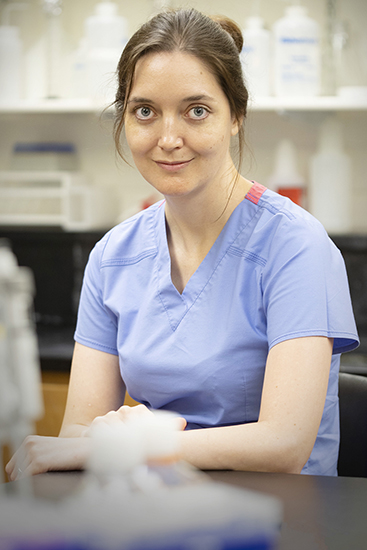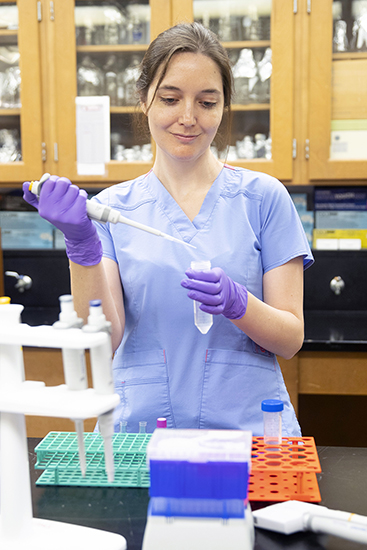A Canine Connection
Story by Dr. Ann Kellett
Through her Dogs Helping Dogs laboratory, Dr. Unity Jeffery studies common canine diseases to improve veterinary care in the future.

If you ask for Dr. Jeffery at the Texas A&M College of Veterinary Medicine & Biomedical Sciences (CVM), you’ll need to be more specific. Dr. Nick Jeffery and Dr. Unity Jeffery are a husband-and-wife team who both devote their lives to advancing animal health care at the CVM.
An assistant professor of veterinary pathobiology, Unity Jeffery utilizes her Dogs Helping Dogs laboratory to better understand, diagnose, and treat common canine diseases.
She got the idea while earning her Ph.D. at Iowa State University.
“To get research funding, small animal veterinarians typically have to focus on problems that overlap with human medicine,” she said. “Dogs Helping Dogs focuses on problems that aren’t so interesting to funding agencies.”
TACKLING THE MOST IMPORTANT PROBLEMS
At the moment, she’s working on some of the biggest problems a dog can have—heatstroke and a disease associated with it (and other conditions), called disseminated intravascular coagulation (DIC).
Heatstroke can occur quickly and is deadly in the majority of cases. It is of particular concern for dogs with thick fur and short noses, as well as those that are obese or have other medical conditions.
DIC is less well known to most dog lovers and occurs when numerous small blood clots form throughout the body in conjunction with a severe illness such as cancer, sepsis, and liver or kidney disease.
About 150 dogs have provided blood for her studies so far. Healthy dogs, mostly the pets of staff and students at the CVM, provide control samples, and others come from dogs that have been treated at the Small Animal Hospital (SAH).
“The patients we work with today are teaching us how to improve future care,” Jeffery said. “I am very grateful for the generosity of the owners and pets who participate in our studies and the technicians, interns, residents, and clinicians who help make this possible.”
Gathering data in these kinds of clinical studies takes much longer than in traditional experimental research, but Jeffery says the enrollment target for two studies was reached in June.
“I’m really excited to see the final results,” she said. “With one study, we’re hoping to take a first step in developing new tests and therapies for dogs affected by heatstroke. The other looks at how different fluid therapies affect the health of blood vessels, which we hope will help us keep patients from developing DIC.”

ASSESSING LABORATORY ACCURACY
Jeffery’s other main focus is to improve the accuracy of the tests given by veterinarians during an examination and the laboratory results of these tests.
“Laboratory and point-of-care analyzers can be marketed to veterinarians even though they may not consistently provide accurate results,” she said. “Laboratory accuracy is important to us because it is a major patient safety issue and we base so many of our diagnostic and treatment decisions on laboratory testing.”
Several projects are underway or recently completed. In one, she and CVM emergency and critical care team member Dr. Christine Rutter worked with a couple of point-of-care instrument manufacturers to assess the performance of their analyzers in clinical patients. In another, she and clinical pathology resident Carolina Azevedo looked at how high blood lipid concentrations interfere with lab testing.
“One of the projects that I’m most excited about is a study involving data from the Morris Animal Foundation’s Golden Retriever Lifetime Project,” Jeffery said. “We’re using annual health check data from the dogs enrolled in this study to determine how much lab results vary in healthy dogs. The results will help us determine if changes detected at annual wellness checks are clinically important or just normal fluctuations.”
Jeffery expects some of these studies to have an immediate impact.
“I hope our fluid therapy study will help improve the standard of care of canine patients almost immediately after it is published,” she said. “Others, like the heatstroke study, are chipping away at a really big problem. It will probably be a few years before it pays off, but without these initial studies we’ll never improve survival for these patients.”
Her colleagues understand the importance of this work.
“I’ve got great collaborators in the Small Animal Hospital who take the time to enroll patients and collect samples, even when their day-to-day clinical work is very demanding,” she said. “This is particularly true of our emergency and critical care service. They deal with the most seriously ill patients in the hospital but they recognize that clinical research holds the key to improving care for their patients.”
###
Note: This story originally appeared in the Fall 2019 edition of CVM Today.
For more information about the Texas A&M College of Veterinary Medicine & Biomedical Sciences, please visit our website at vetmed.tamu.edu or join us on Facebook, Instagram, and Twitter.
Contact Information: Jennifer Gauntt, Director of Communications, Texas A&M College of Veterinary Medicine & Biomedical Sciences; jgauntt@cvm.tamu.edu; 979-862-4216


